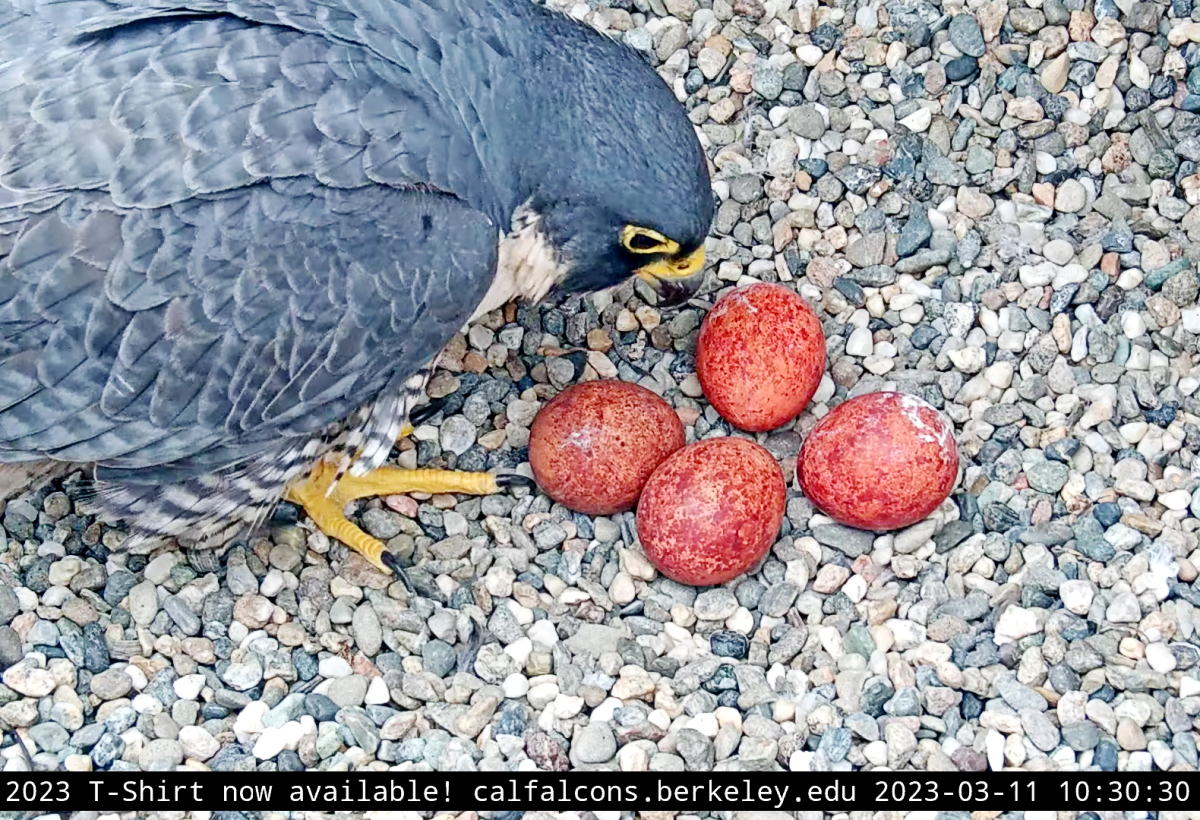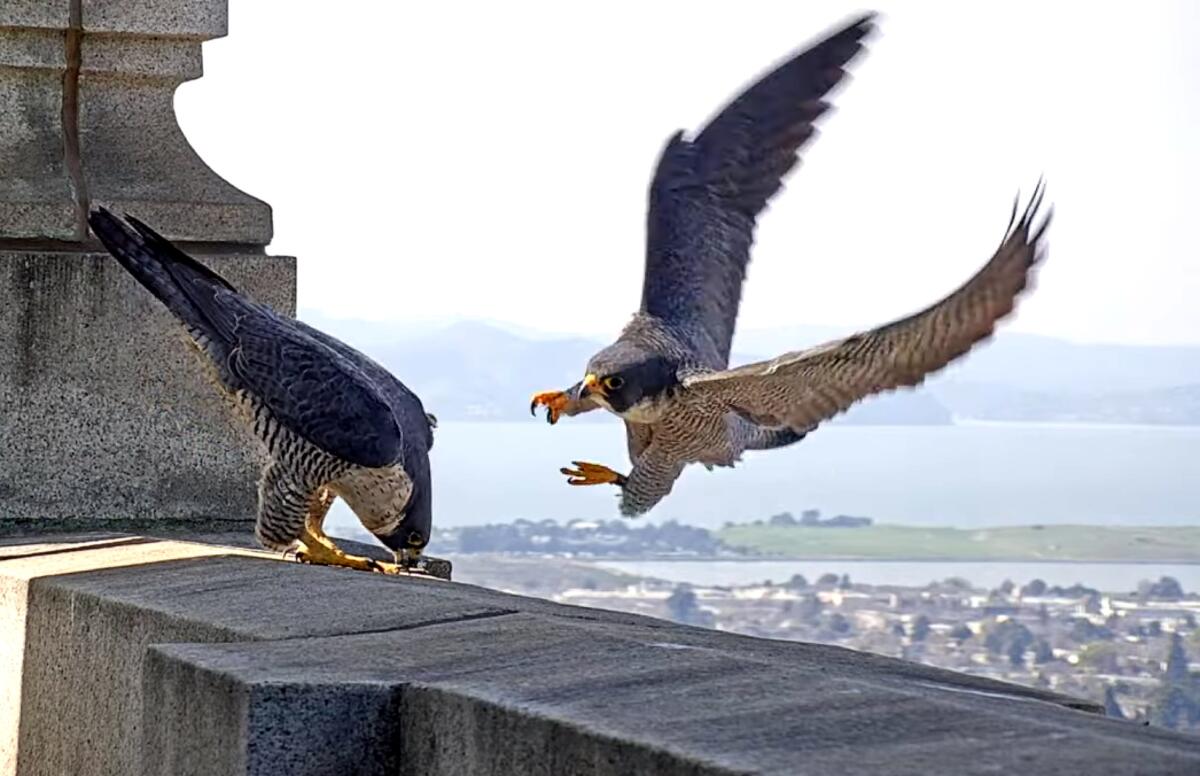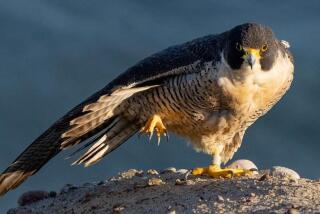Four eggs and a bell tower: Peregrine falcon chicks set to hatch at UC Berkeley in livestream

Four falcon eggs atop a bell tower at UC Berkeley are about to get a crack at fame as they join a storied lineage at the university.
On Tuesday, UC Berkeley â and the many online fans of the schoolâs peregrine falcons â will celebrate Hatch Day, when the chicks are expected to peck their way out of their shells and make their debut, according to bird experts who monitor the nest.
Once they emerge, these chicks will join a bird dynasty that boasts an online fandom that follows the falconsâ movements with the rapt attention an audience might give to a reality TV show.
The last few seasons of the bird drama have featured a love triangle, a mysterious death and a stepfather who swooped in to help a single mother.
Now comes the possible addition of four new birds into the mix. The momentous occasion will be livestreamed and projected onto a large screen near the campus.
For bird watchers, the day is a chance to celebrate Annie and Lou, the parents of the latest clutch in the nest. They are currently taking turns sitting on the eggs, and their switching places and other activities are captured on webcams atop the Campanile tower at the Berkeley campus.
The group Cal Falcons, which is not part of the university, watches over the nest and posts video clips to social media channels with updates on how the falcons are holding up.
In one clip, the falcons noisily chirp at each other as rain pelts their nest and they scramble to sit on the eggs.
âI wish I understood falcon language,â one person wrote in the comments.
âSuch squabbling, and in front of the children!â another person wrote.
Since 2016 when the first falcon couple made a nest atop the tower, viewers have come to see the birds as having distinct personalities, although experts say falcons shouldnât be viewed through such a lens. But anthropomorphizing â assigning human qualities to animals â isnât all bad, Cal Falcons volunteer Mary Malec said. Itâs kept viewers enrapt.
âSometimes itâs hard to listen to,â Malec said about people weighing in online on the decisions the birds make as though they were plot twists in a telenovela.
Falcons are not in the business of making good drama, she added; their motivation is survival.

In late 2016, two peregrine falcons were spotted on the Berkeley campus, and in the following months a makeshift nest was found on top of a sandbag on the clock tower.
The Cal Falcons group managed to create a safe site for the falcons to nest. The falcon pair were named Annie and Grinnell, and they managed to fledge multiple chicks over the years, experts said.
It was very dramatic for the online fan and scientists when Grinnell was found wounded near a tennis club a few miles from his nest in October 2021.
Experts suspected another falcon had attacked him.
Grinnell was taken to a wildlife rehabilitation hospital and while he recuperated, Annie was seen with another male partner. The other falcon could have been one of the falcons who attacked Grinnell, experts said at the time. Fans chided Annie for going off with some other male.
But, Malec said, these are wild animals.
âItâs not that Annie is being unfaithful in any way to Grinnell,â Malec said. âSheâs doing what is best for her survival and for the survival of the next generation of peregrines.â
Grinnell eventually recovered and returned to the nest but was found dead in May 2022 not too far from campus, according to Sean Peterson, a Cal Falcons supporter who is an associate professor at St. Olaf College in Minnesota.
Nesting in UC Berkeleyâs bell tower, peregrine falcons Annie and Grinnell always seemed to soar above the world of human drama. In the last year, all that changed.
Annie was then alone with her clutch of eggs, but within several hours of Grinnellâs death, another male swooped in and took his place, Peterson said.
The online fandom dubbed the new male Alden. But after he helped save the eggs in the nest, Alden mysteriously disappeared in November 2022.
âIt was just a successful mess,â Peterson said. âBut we donât know what happened to him.â
Eventually, Lou arrived. And although Annieâs latest mate is a few years younger, he seems eager to be a parent, Peterson said. The two often squawk at each other as they take turns sitting on the eggs.
Again, these are merely birds doing their thing, Peterson said, but he can understand how the falcons remind their fans of parents taking care of their children.
âTheyâre very good parents; they care for their chicks exceptionally well. So, people really kind of resonate with that,â Peterson said.
Of course, he noted, part of that is preparing hearty meals of dead birds and other prey for the young chicks. There are no jars of mashed bananas in a falconâs nest.
Hatch Day is a party for the community that has followed the birds over the years, but itâs is also another chapter in a remarkable turnaround for a species that was once on the brink of extinction.
Peregrine falcon populations sharply declined from the 1950s through the â70s with the liberal use of the pesticide DDT, according to ornithologists who study the species.
The insecticide made its way into the food chain and caused eggshells to become frail and brittle. It meant the mother birds could not sit on their eggs without crushing them, according to Doug Bell, wildlife program manager at the East Bay Regional Park District.
By 1973, there were only five peregrine falcon nesting sites in California, Bell said. The species has managed to bounce back after several decades of conservation efforts and a federal ban on DDT. There are currently more than 400 breeding pairs in California alone, according to the state Department of Fish and Wildlife.
âI still have to pinch myself when I see a peregrine falcon: âWow, theyâre back. And theyâre everywhere now,ââ said Bell, who grew up in the San Francisco Bay area in the 1960s and never saw the birds in the wild.
The Berkeley falcons made their nest in an unlikely place, and itâs unclear if they will remain atop the bell tower for another season. But it is clear that theyâve inspired people to appreciate the raptors in a whole new light.
Anne Prestridge from Orange County warned her book club last year she would be late to one of their meet-ups because the Cal Falcons scientists were hosting an online Q&A session.
The private piano teacher has long been fascinated by wildlife, but when Prestridge started following the Berkeley falcons in 2019, she found herself regularly checking the webcam feed. She was so inspired by the falcons that she decided to take a birding class so she could identify birds in her own neighborhood.
âIâm here in Orange County watching a webcam, but in my own backyard thereâs a pair of falcons,â Prestridge said. âI just wasnât putting the two together.â
She still plans to watch the webcam when the chicks hatch on Tuesday.
More to Read
Sign up for Essential California
The most important California stories and recommendations in your inbox every morning.
You may occasionally receive promotional content from the Los Angeles Times.












